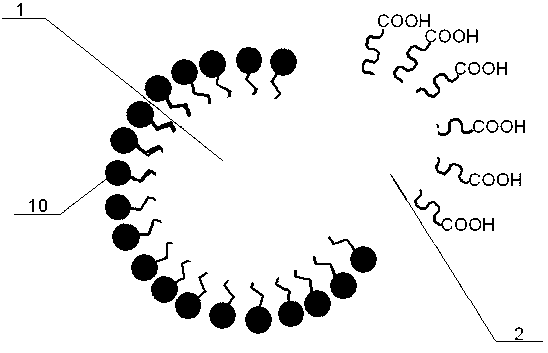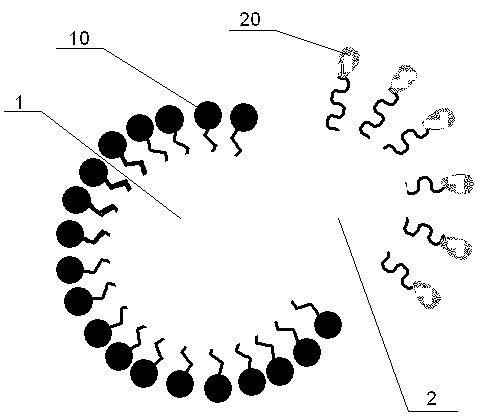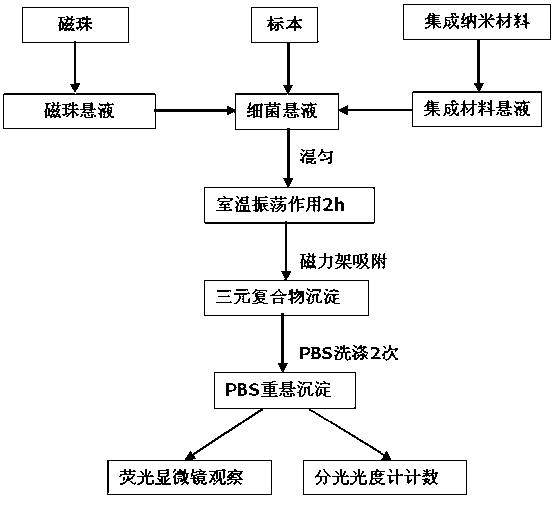Nanometer material probe system and detection method for tubercle bacillus detection
A Mycobacterium tuberculosis, nanoprobe technology
- Summary
- Abstract
- Description
- Claims
- Application Information
AI Technical Summary
Problems solved by technology
Method used
Image
Examples
Embodiment 1
[0056] Step 1, preparation of functionalized nano-magnetic beads
[0057] In the presence of sodium citrate, ferric ions were reduced with ethylene glycol, and reacted at 200°C and 2 atmospheres to prepare magnetic microspheres.
[0058] The silicon oxide shell layer is prepared by a sol-gel method, the magnetic microspheres are coated, and then the amino groups are modified on the surface of the magnetic microspheres by using the hydroxyl groups on the surface of the silicon oxide and the carboxyl groups of the silane coupling agent with amino groups.
[0059] Reaction with acid anhydride and amino group to obtain magnetic microspheres with carboxylation on the surface.
[0060] Step 2, preparation of integrated nanomaterials
[0061] First, the sol-gel method is used to synthesize silicon oxide particles, and the powder is obtained by freeze-drying. The silicon oxide particles are stabilized at the water / toluene two-phase interface by stirring, and then the silane coupling ...
Embodiment 2
[0074] Step 1, preparation of functionalized nano-magnetic beads
[0075] In the presence of succinic acid, trivalent iron ions were reduced with glycerol, and reacted at 200°C and 2.7 atmospheric pressure to prepare magnetic microspheres.
[0076]The silicon oxide shell layer is prepared by a sol-gel method, the magnetic microspheres are coated, and then the amino groups are modified on the surface of the magnetic microspheres by using the hydroxyl groups on the surface of the silicon oxide and the carboxyl groups of the silane coupling agent with amino groups.
[0077] Reaction with acid anhydride and amino group to obtain magnetic microspheres with carboxylation on the surface.
[0078] Step 2, preparation of integrated nanomaterials
[0079] First, the sol-gel method is used to synthesize silica particles, and the powder is obtained by freeze-drying. The silica particles are stabilized at the water / chlorobenzene two-phase interface by stirring, and then the silane couplin...
Embodiment 3
[0089] Step 1, preparation of functionalized nano-magnetic beads
[0090] In the presence of sodium citrate, ferric ions were reduced with isopropanol and reacted at 200°C and 1.2 atmospheric pressure to prepare magnetic microspheres.
[0091] The silicon oxide shell layer is prepared by a sol-gel method, the magnetic microspheres are coated, and then the amino groups are modified on the surface of the magnetic microspheres by using the hydroxyl groups on the surface of the silicon oxide and the carboxyl groups of the silane coupling agent with amino groups.
[0092] Reaction with acid anhydride and amino group to obtain magnetic microspheres with carboxylation on the surface.
[0093] Step 2, preparation of integrated nanomaterials
[0094] First, the sol-gel method is used to synthesize silicon oxide particles, and the powder is obtained by freeze-drying. The silicon oxide particles are stabilized at the water / xylene phase interface by stirring, and then the silane coupling...
PUM
 Login to View More
Login to View More Abstract
Description
Claims
Application Information
 Login to View More
Login to View More - R&D
- Intellectual Property
- Life Sciences
- Materials
- Tech Scout
- Unparalleled Data Quality
- Higher Quality Content
- 60% Fewer Hallucinations
Browse by: Latest US Patents, China's latest patents, Technical Efficacy Thesaurus, Application Domain, Technology Topic, Popular Technical Reports.
© 2025 PatSnap. All rights reserved.Legal|Privacy policy|Modern Slavery Act Transparency Statement|Sitemap|About US| Contact US: help@patsnap.com



